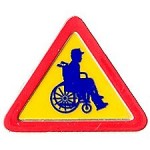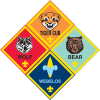Belt Loop
Complete these three requirements
- Visit with a friend, family member, classmate, or other person with disabilities. Find out what this persons enjoys and what this person finds difficult.
- Attend a disabilities event such as an Easter Seals event, Special Olympics, a performance with sign language interpretation, an activity with Guiding Eyes dogs, or a wheelchair race. Tell your adult leader what you thought about the experience.
- Make a display about one or more disabilities. It can include physical, learning, or mental challenges. Share the display at a pack meeting.
Academics Pin
Earn the Disabilities Awareness belt loop and complete five of the following requirements.
- People with disabilities move around in different ways such as crutches, scooters, and wheelchairs. Explain the differences. With an adult’s supervision and permission, try to safely use one.
- Using sign language, demonstrate the Cub Scout Promise and motto.
- Read a book about a person with a disability.
- Explain how your school helps students with disabilities (elevators, ramps, small classes, special tools and equipment, specialized teachers).
- Describe one of the following and its purpose: occupational therapy, speech therapy, or physical therapy. Visit with a person who works in one of these fields and learn about his or her position.
- Read about a famous person who has been physically or mentally challenged. Report what you learned to your den or family.
- For two one-hour periods, and with adult supervision, go about your normal routine doing chores, watching television, studying, etc. Change your abilities by using one of these experiences, then share what you learned with your den.
- Hearing impairment—Muffle your ears with earmuffs or bandages.
- Sight impairment—Blindfold one or both eyes.
- Physical impairment—Bind an arm or leg so that it cannot be used.
- Speaking impairment—Cover your mouth or do not speak.
- Choose an impairment of your own that is approved by an adult.
- Look at a catalog and find three items that could help a person with disabilities in their daily life. Explain how each item would help the individual.
- Volunteer and help someone with disabilities in school, sports or another supervised activity.
- Visit a nursing home or elderly person and help someone with a meal.
- Talk to someone who works with people who have disabilities. Ask what the person’s position is like and how he or she helps people with disabilities.
Additional Information
Occupational therapy: Therapy that uses creative activities in rehabilitation (therapy to improve upon a lost or weakened function) related to physical, mental, and emotional disabilities.
Speech therapy: Therapy that uses exercises and audiovisual aids in building new speech habits.
Physical therapy: Therapy that uses exercise, massage, hydrotherapy (water therapy), etc., for the treatment of physical disabilities as an alternative to treatment such as medicine or surgery.
Resources
Your local library, schools, and the Internet are all excellent sources of information about disabilities awareness. These organizations and agencies may also be helpful. Be sure you have your parent’s or adult partner’s permission before you go online.
American Association of People With Disabilities
Toll-free phone: 800-840-8844
Web site: http://www.aapd.com
American Foundation for the Blind
Toll-free phone: 800-232-5463
Web site: http://www.afb.org
The Arc of the United States
Phone: 301-565-3842
Toll-free phone: 800-433-5255
Web site: http://www.thearc.org
Autism Society of America
Phone: 301-657-0881
Toll-free phone: 800-328-8476
Web site: http://www.autism-society.org
Autism Speaks
Phone: 212-252-8584
Web site: http://www.autisimspeaks.org
Easter Seals
Toll-free phone: 800-221-6827
Web site: http://www.easterseals.com
Federation for Children With Special Needs
Phone: 617-236-7210
Web site: http://www.fcsn.org
Guide Dogs for the Blind
Toll-free phone: 800-295-4050
Web site: http://www.guidedogs.com
International Dyslexia Association
Phone: 410-296-0232
Web site: http://www.interdys.org
Muscular Dystrophy Association
Toll-free phone: 800-572-1717
Web site: http://www.mda.org
National Alliance on Mental Illness
Phone: 703-524-7600
Web site: http://www.nami.org
National Association of the Deaf
Phone: 301-587-1788
TTY phone: 301-587-1789
Web site: http://www.nad.org
National Center for Learning Disabilities
Phone: 212-545-7510
Toll-free phone: 888-575-7373
Web site: http://www.ncld.org
National Dissemination Center for Children With Disabilities
Toll-free phone: 800-695-0285
Web site: http://ww.nichcy.org
Special Olympics International
Toll-free phone: 800-700-8585
Web site: http://www.specialolympics.org
United Cerebral Palsy
Toll-free phone: 800-872-5827
Web site: http://www.ucp.org






